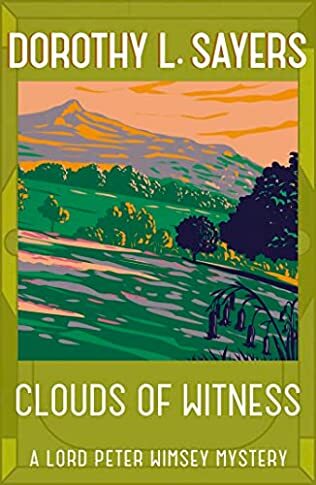Clouds Of Witness

A review of Clouds of Witness by Dorothy L Sayers – 20230330
Lord Peter Wimsey is not everybody’s cup of tea either as a character or an amateur sleuth, I am immediately taken back to Ian Carmichael’s portrayal of him whenever I come across him in print, but he does get involved in some entertaining, if somewhat improbable, escapades. Clouds of Witness is the second in Dorothy L Sayers’ series, originally published in 1926, and sees her amateur sleuth involved in a case that is too close to home for comfort.
Lord Peter cuts short his jaunt sur le continent when he hears the astonishing news that his brother, Gerald, the Duke of Denver, has been arrested, accused of the murder of Denis Cathcart at a shooting lodge in the wilds of Yorkshire which he had hired, as you do, for the season. To add to the intrigue Cathcart is the fiancé of Mary Wimsey, sister of Peter and Gerald, whom Gerald had just accused, based on information received in a letter that he can no longer find, that Cathcart was a card sharp. Gerald protests his innocence but will not give an explanation as to his whereabouts at the time of Cathcart’s death nor why he was up and about at 3am when he was discovered by the body.
Mary’s behaviour at the time of Cathcart’s demise also requires some explanation, which she is loathe to give. She too was fully dressed at 3am when she found her brother by the body. Why and why had she placed a suitcase in the conservatory?
Lord Peter Wimsey cannot resist the challenge of preserving the family’s honour by riding to the rescue of his brother. Aided and abetted by his police ally, Inspector Parker, Wimsey finds that in proving Gerald’s innocence he is likely to incriminate Mary and by establishing that Mary could not have killed her fiancé he is making Gerald’s ultimate fate more likely. He is on the horns of a dilemma, the only way out to save his siblings and the good name of the family is to find an alternative explanation to Cathcart’s death.
In doing so, Wimsey runs incredible and extraordinary risks. He is shot at and wounded, an injury from which he makes an astonishing recovery as shortly afterwards he is swallowed up by a bog and has to be hauled out by his ever-faithful valet, Bunter, and some farm hands, and then undertakes a perilous aeroplane journey across the Atlantic having secured some vital evidence. Wimsey’s sense of family honour is sorely tested.
One of the fascinating points of the set up is that a peer of the realm cannot be tried for murder in an ordinary court setting. They must be tried by a special court consisting of their peers and this allows Sayers to produce some fascinating scenes as the trial proceeds, establishing the court scene where passages of the speeches for the prosecution and defence and the judge’s summing up are transcribed almost verbatim as a staple feature of crime fiction for decades to come.
Inevitably, there are family secrets which come out into the open, an extra-marital affair and a planned elopement with a socialist, by gad, and the key clues are a piece of blotting paper and a letter that was wedged into a window frame in an unexpected property. Sayers keeps the tension going as first one suspect and then another seem to be in the frame for the murder and while justice is done, the reader might feel a little cheated at how Cathcart’s death is resolved. The final chapter is fast and furious, wrapping up most of the loose ends, including release for a woman trapped in a violent and loveless marriage, and an opportunity for his Lordship and Parker to let their hair down.
It might not be the most complex or sophisticated of mysteries, but it is terrific fun.



